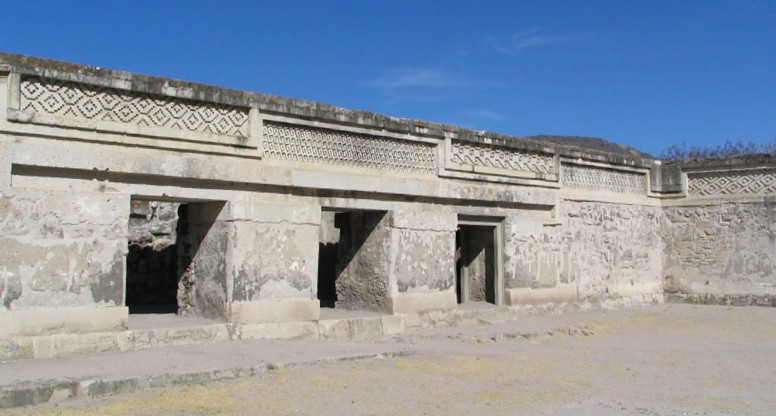The word Mitla comes from the Náhuatl word Mictlan, meaning place of the dead or underworld. In the Zapotec language this place is called Lyobaa, meaning place of rest or burial place.
 The Mitla archaeological site is located within the town of Mitla, officially San Pablo Villa de Mitla, at the northern end of town. The site is located in the Tlacolula Valley which is one of the three valleys that intersect at the archaeological site of Monte Albán to the west. Mitla is 48km east of Oaxaca, at an elevation of 4855' (1480 meters). From Oaxaca city, travel east of Hwy 190 and follow the signs to Mitla.
The Mitla archaeological site is located within the town of Mitla, officially San Pablo Villa de Mitla, at the northern end of town. The site is located in the Tlacolula Valley which is one of the three valleys that intersect at the archaeological site of Monte Albán to the west. Mitla is 48km east of Oaxaca, at an elevation of 4855' (1480 meters). From Oaxaca city, travel east of Hwy 190 and follow the signs to Mitla.
 Mitla was inhabited in the Classic Period (100-650 AD), and possibly as early as 900 BC. It appears to have been at its peak occupation in the Post Classic Period (750-1521 AD). It was inhabited by the Zapotec people although it was under the control of the Mixtecs from about 1000 AD to 1200 AD and then fell to the Aztecs in 1494. It is the Mixtec influence that is most evident in the ruins today.
Mitla was inhabited in the Classic Period (100-650 AD), and possibly as early as 900 BC. It appears to have been at its peak occupation in the Post Classic Period (750-1521 AD). It was inhabited by the Zapotec people although it was under the control of the Mixtecs from about 1000 AD to 1200 AD and then fell to the Aztecs in 1494. It is the Mixtec influence that is most evident in the ruins today.
The site contains five main groups of structures
- Grupo de las Columnas (Columns Group)
- Grupo de las Iglesias (Churches Group)
- Grupo del Arroyo (Arroyo Group)
- Grupo de los Adobes (Adobe Group)
- Grupo del Sur (Southern Group)
| |
 Features of the site include numerous columns, two public squares, tombs, and geometric decorations. Grupo de las Columnas and Grupo de las Iglesias were fully excavated and restored by the early 1980s. Each group has several rectangular patios bordered by long, narrow rooms. Those in the Grupo de los Adobes and in the Grupo del Sur are bordered by rooms and stepped pyramids. The Grupo de las Columnas measures 120 x 21' with 6 columns of volcanic stone that once supported the roof.
Features of the site include numerous columns, two public squares, tombs, and geometric decorations. Grupo de las Columnas and Grupo de las Iglesias were fully excavated and restored by the early 1980s. Each group has several rectangular patios bordered by long, narrow rooms. Those in the Grupo de los Adobes and in the Grupo del Sur are bordered by rooms and stepped pyramids. The Grupo de las Columnas measures 120 x 21' with 6 columns of volcanic stone that once supported the roof.
 The construction of the stone walls appears to have been the same for all groups: a core of mud and stone covered with plaster or well-cut trachyte. The geometric patterns called grecas seen on some of the stone walls and door frames are made from thousands of cut, polished stones that are fitted together without mortar. The pieces were set against a red stucco background. Cruciform lithic tombs have been discovered beneath both the Grupo de las Columnas and the Grupo del Sur. So far, all of the tombs that have been discovered were found to be empty.
The construction of the stone walls appears to have been the same for all groups: a core of mud and stone covered with plaster or well-cut trachyte. The geometric patterns called grecas seen on some of the stone walls and door frames are made from thousands of cut, polished stones that are fitted together without mortar. The pieces were set against a red stucco background. Cruciform lithic tombs have been discovered beneath both the Grupo de las Columnas and the Grupo del Sur. So far, all of the tombs that have been discovered were found to be empty.
 The village of Mitla is located on the hillside below the ruins. The Museo Frissell de Arte Zapoteca is located in the village and houses a collection of artifacts from Mitla and neighboring sites.
The village of Mitla is located on the hillside below the ruins. The Museo Frissell de Arte Zapoteca is located in the village and houses a collection of artifacts from Mitla and neighboring sites.
|
